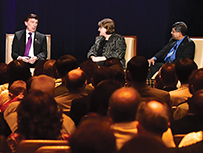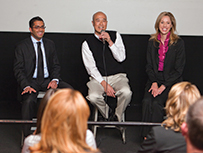Listen to an interview with Kristin Arnold and the hosts of The Toastmasters Podcast.
At a time when panel discussions are becoming increasingly popular in online meetings, political debates, and business presentations, knowing how to moderate a panel—and especially to do so virtually—is a valuable skill for any presenter.
Panel discussions are a fabulous format in this volatile and uncertain world where one person does not have the definitive answer to the topic at hand. Hearing multiple perspectives helps us understand common themes and appreciate diverse points of view.
Moderating a panel can be both terrifying—you have no control over what people will say—and electrifying. Add the technology and the “virtual” element to it, and it can be downright overwhelming. All the little things that a live audience won’t see (or forgive) get magnified online. Not to worry! Moderating a panel is similar to learning speaking skills: The more you moderate, the better you will be.
Here are my top 10 tips to moderating a lively and informative virtual panel discussion:
1 Prepare.
Research the topic, the panelists, and the audience beforehand, and consult the meeting chair and planner to learn more about the event format and how much latitude you have to be creative.
2 Know your platform.
Don’t expect to just “hop on” to whatever platform your meeting organizer has scheduled. Learn the platform capabilities—e.g., chat box or polling features—and figure out if you want to use them. If your audience is brand new to virtual panels/webinars, then keep it simple. Don’t try to use every feature available!
3 Select, invite, and confirm interesting panelists.
If panelists have not yet been selected, round up DEEP people who can sufficiently address the topic:
- Diverse. Make sure the panel represents the demographic of the audience while ensuring a diversity of opinion and thoughts. A group that is in complete agreement can make a discussion boring.
- Expertise. Invite a recognized authority or thought leader in the industry who possesses strong credentials. That person must establish credibility with the audience quickly via a biography or a 30-second introduction.
- Eloquent. Panelists should be good conversationalists. Do they speak well on the phone? Did your interview with them produce a monologue or a back-and-forth discussion? Review video footage of your potential panelists to make sure they can keep the audience engaged and interested.
- Prepared. Panelists must be willing to make a few key points and tell stories that illustrate those points. Preparation makes the difference between a mediocre panel and an amazing one.
4 Craft great questions.
Get the conversation started quickly with well-prepared questions. Start with broad questions to set the tone for the discussion. Next, move to stating the reasons the audience should care, and then ask specific questions to spur the panelists to share anecdotes, concrete examples, and implementation ideas. Be willing to let go of your planned questions when an interesting discussion emerges. (For more on preparing questions, see the sidebar on the right.)
5 Select the Q&A format.
You don’t need to save your question-and-answer session for the end. As people come into the virtual room, pose a quick question via the chat box, and as they answer, welcome them by name. Periodically pause and take audience questions from the chat box, ask people to “raise their hand,” and invite them in to pose their question, or put people into virtual breakout rooms to submit their most challenging question.
6 Practice.
Practice on that platform with the panelists. Get comfortable with the technology and the functions you want to use. Make sure the audio and video work for all panelists—and that they all have enough bandwidth—during the dry run and 30 minutes before the panel starts. Show the panelists how to log on, mute themselves (especially if they have a coughing fit!), and turn the camera off (if for some reason they need to leave for a moment). Ensure there is adequate lighting on each panelist’s face—and that the camera isn’t looking up their nose. Don’t forget to look at everything in the video frame and audio range and remove any distracting elements.
7 Start strong.
Online audiences get bored quickly, so start with a short, interesting hook to grab everyone’s attention. Plan how you will introduce yourself and welcome the audience, as well as describe the technology, topic, and panelists. Dispense with the long preamble and get right into the discussion within the first three minutes. You want your audience to be leaning into the conversation and refusing to multitask.

8 Keep the conversation moving.
If you have prepared the panelists appropriately, and you kick off the discussion with a few good questions, the conversation will start to flow on its own. Encourage each panelist to comment on particular parts of other panelists’ statements. You may need to interject a follow-up question here and there to keep the conversation moving at a brisk pace. Probe deeper, make bridges between ideas, present opposing views, catch contradictions, test the unsaid, shift gears, create transitions, and intervene firmly and respectfully to keep everyone on track.
9 Shift gears.
Audiences get bored when the conversation stays between the moderator and the panelists. You’ll have to deliberately mix it up. Take questions from the chat box, take a quick poll, conduct a panelist “lightning round,” call on a participant. The choices are endless—but you’ll have to think it through using the technology.
10 Be positive.
Always be uplifting. Bring positive energy to the virtual room. Compliment the audience and the panelists. Make it personal by using the panelists’ first names and saying the name of the person who submitted the question.
11 Put a bow on it.
Let the audience know the program is coming to an end by saying, “We’re almost out of time. There are a few key things to wrap up.” Then, summarize the discussion (or have your panelists do it) and offer opportunities to extend the discussion beyond the session. Make final announcements and conclude with heartfelt words of thanks and a round of applause.
12 Have a backup plan.
Consider what could go wrong and try to prevent it from happening. Here’s my go-to backup plan for virtual panel discussions:
- Have all the panelists log on 30 minutes prior to the start time of the panel to check all the equipment. Now you’ll have some time to troubleshoot any problems.
- Have the cell phone number of all the panelists just in case the audio or video drops. Know how to connect them via audio.
- Make sure your panelists shut down all programs running concurrently on their computers to maximize bandwidth.
- Check that your panelists have a pair of headphones or earbuds at the ready in case there is audio feedback.
- Have some interesting backup questions in your back pocket—just in case there aren’t any questions that come in from the audience!
Especially in the virtual world, it’s easy to have a chitchat with the panelists and literally lose sight of your audience. As the panel moderator, you are the champion for the audience. Always keep them in mind and make sure their needs are being met throughout the entire session.
Editor’s Note: “Moderating a Panel Discussion” is a Level 5 elective project in all 11 paths of the Toastmasters Pathways learning experience.
Kristin Arnold is on a crusade to make all panel discussions lively and informative. She is a meeting facilitator, moderator, and keynote speaker with over 30 years of experience making meetings more engaging, interactive, and collaborative. You can find more information about her latest book, The Powerful Panelist, at powerfulpanels.com.
Related Articles

Communication
10 Ways to Add More Pizzazz to Your Panel Discussion

Presentation Skills


 Previous
Previous
 POWERFUL PANELS
POWERFUL PANELS
 Previous Article
Previous Article